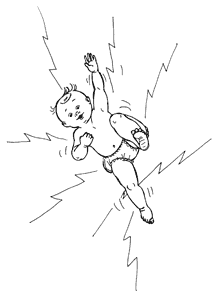STRANGE BUT TRUE- Baby power: Tots' awesome cosmic energy

DRAWING BY DEBORAH DERR
Q. So many wonderful ways to look at a kicking, crying, arm-waving newborn baby. For instance, how much cosmic energy does the little darling represent? –R. Ford
A. E = mc2–that's Einstein's most famous equation. The E stands for the energy bound up in ordinary amounts of mass, the c represents the speed of light, or 186,000 miles (300,000 kms) per second! Squaring the speed of light, you get a sense of how even a little mass– like the "stuff" in a newborn– is worth a lot of energy, says Nigel Calder in Magic Universe.
Say the babe weighs three kilograms: A hurricane would have to rage for an hour or a large power station run for a year to match the cosmic energy in that bouncy body. "If the parents had to pay for the energy, it would cost them a billion dollars."
Q. If we don't have lots more genes than a mouse– about 30,000 for each– what do we have to make us "lords of the realm"? More junk DNA can't be it, can it? –F. Crick
A. It's not really how many genes but how they're regulated or expressed during development, says Hopi Hoekstra of UC-San Diego. In fact, we have scarcely more genes than worms and fleas and far fewer than salamanders. Secondly, "junk DNA" is something of a misnomer; there is clear evidence that these regions not coding for proteins are full of gene-regulatory elements.
"In other words, some non-coding DNA regions have function, even if termed 'junk,' and these control gene expression. Finally, there's simply no correlation between genome size and organismal complexity," Hoekstra says. As for our being "lords of the realm," adds Stanford geneticist Matthew P. Scott, while it's true our brain's cortex sets us apart in language and thinking, in other regards many species can outdo us– birds flying, bats navigating by sonar, bears smelling food miles away. These abilities arise often from changes in "control elements" rather than sheer numbers of genes.
Plus, "I think that insects and some microbes might view our lordly status as temporary at best... at least it seems that way when I try to keep flies and ants out of my kitchen," Scott says.
Q. At a bar, someone wants to bet $100 that he can play you a hundred games of tic-tac-toe and you won't win a single game. Can you really be that bad? –T. Cat
A. Careful here. There are actually few sequences of possible moves in a game, since by arguments of symmetry, all corner openings are essentially the same, as are all mid-side marks. So it's no problem analyzing how games will go, and a skilled player can always play to at least a tie.
The no-lose strategy: If your opponent opens in the center, you must mark a corner. Going to a side cell will be fatal. If your opponent opens in a corner, go to the center. To counter a side opening, go next to the center, adjoining corner or far side. If you open the game instead, any first cell play can lead to victory, but only if your opponent blows it.
Q. How critical is self-confidence to an Olympic racer? –J. Gatlin
A. It's the psychic fuel that takes an athlete over the top. Doubting oneself will create a self-fulfilling prophecy, a vicious cycle where the expectation of failure brings on actual failure that lowers self-image and increases expectations of even further failures, say Robert Weinberg and Daniel Gould in Foundations of Sport and Exercise Psychology.
Olympic miler Roger Bannister in 1954 would have none of this. Although runners had been timed at 4:03, 4:02 and 4:01, many people believed that to get below 4 minutes was physiologically impossible. Bannister nonetheless felt confident he could break the 4-minute barrier under the right conditions– and he did!
What was really interesting was that in the next year more than a dozen runners broke the 4-minute mile. Did everyone suddenly get faster? Of course not, Weinberg and Gould answer. Runners finally believed it could be done, took the psychological limits off themselves, and away they ran.
Q. Empathy– being able to feel for another person– is akin to sympathy or compassion. Can this subtle capacity be detected by an MRI? –J. Yates
A. In an fMRI brain scan, empathy resembles a sort of minor constellation, with clusters of encephalic stars glowing in the cosmos of an otherwise dark brain, says Lydialyle Gibson in University of Chicago Magazine. This signature network of cells lights up not only when a subject witnesses someone else in pain but also when the subject experiences pain firsthand, though the constellations are somewhat distinct.
"The brain knows the difference, and that is important." Empathy begins with shared emotion, says neuroscientist Jean Decety, and is hard-wired into our brains. A baby hearing another baby cry will begin to cry too, while people of all ages will unconsciously mimic the facial expressions of those they see.
But empathy can be learned as well. The good car salesperson is the one with empathy, as is the good boss, teacher, doctor (the doctor who can feel for you will mysteriously help you feel better). Yet people who lose themselves too much in another's distress may sacrifice their capacity to help.
"In human society, empathy is the glue," says Decety, pulling our separate paths together into shared feeling. Amazingly, this ancient glue is now detectable by science.
Send Strange questions to brothers Bill and Rich at [email protected].
#